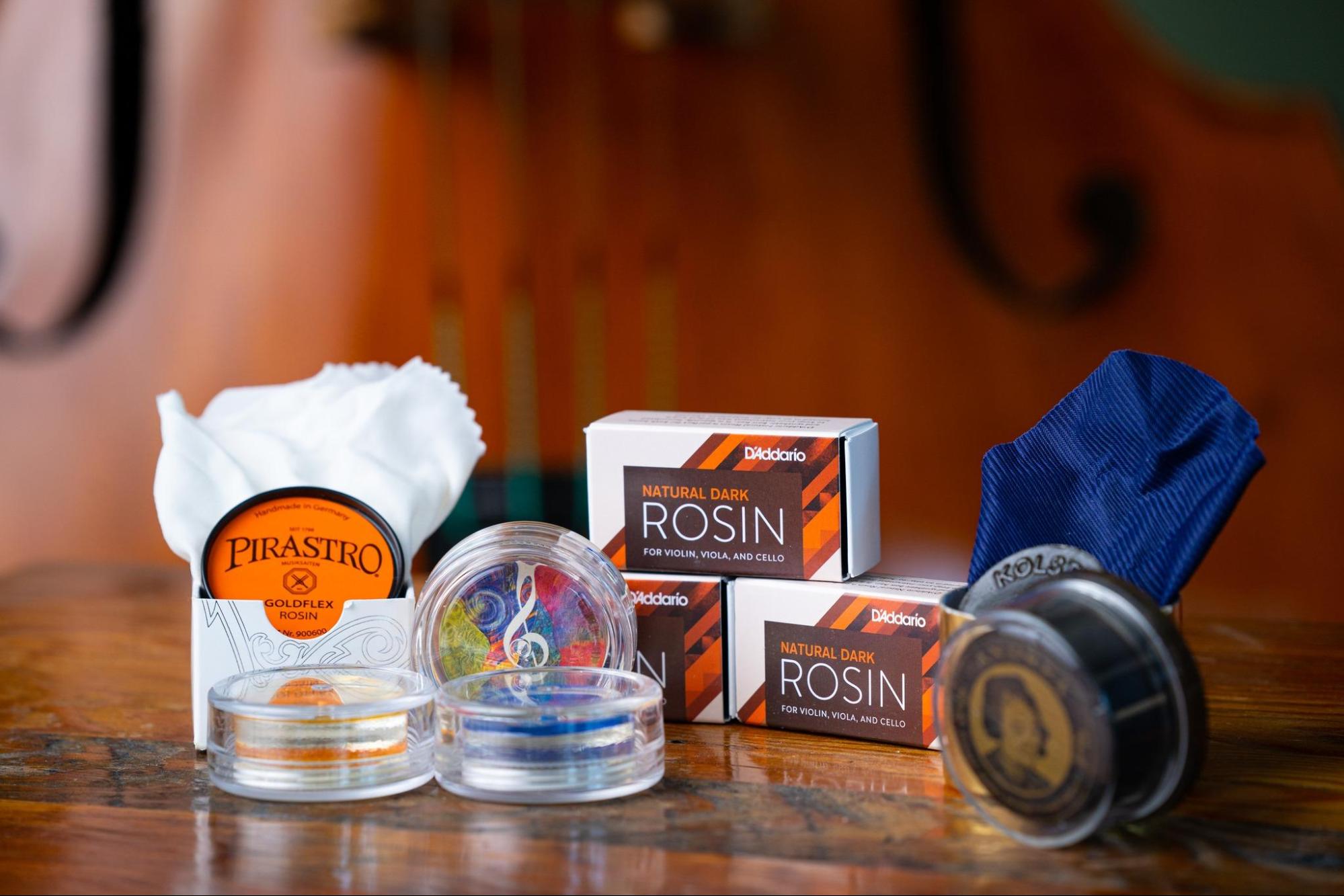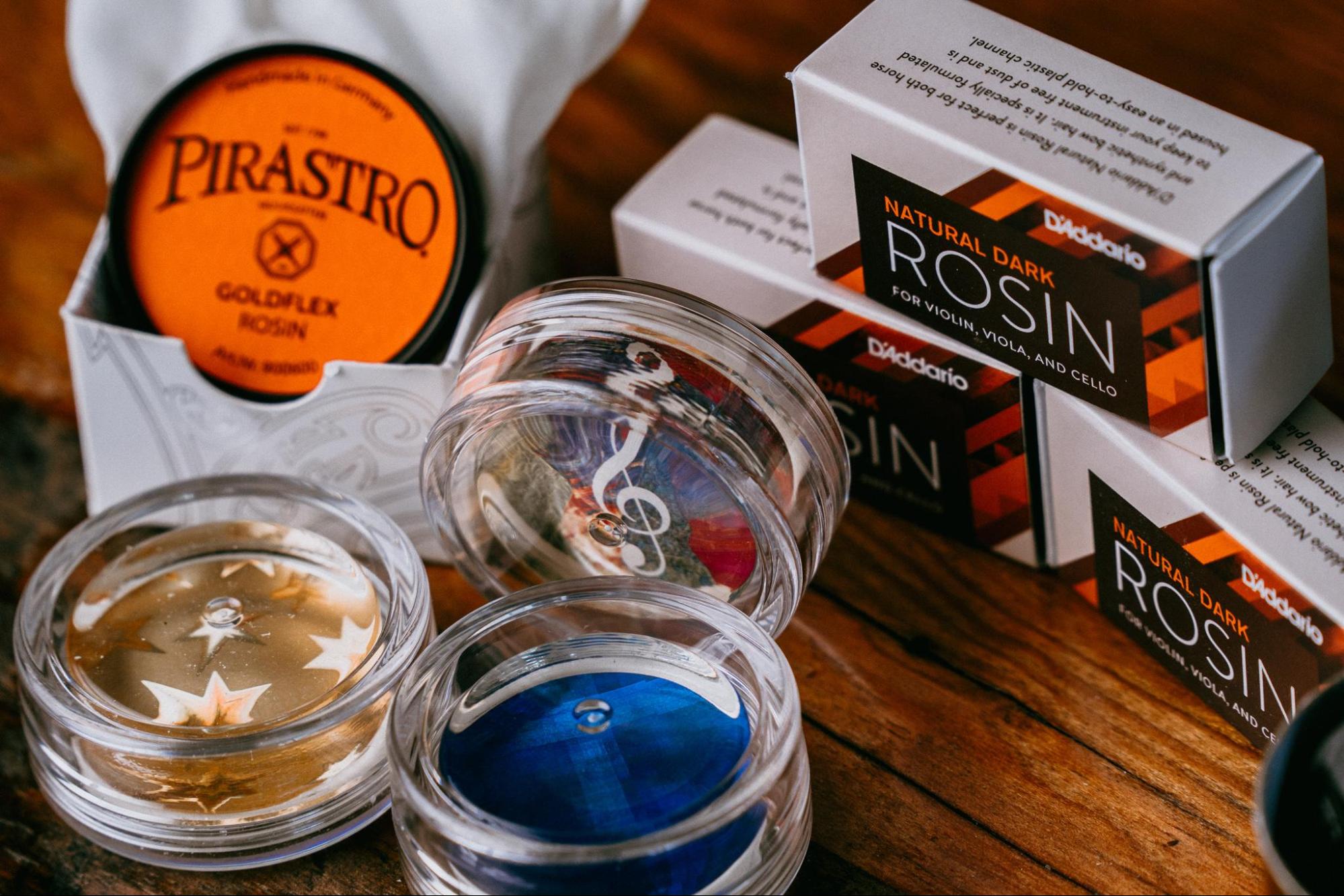Welcome to the world of violinists, where the melody isn’t just in the strings but also in the tiny details that make every performance seamless. Think of your violin case as a treasure chest, holding your precious instrument and those little lifesavers that can make or break your musical journey. This blog will dive into the eleven must-have accessories for your violin case. Each accessory plays a pivotal role, from the magic touch of rosin to the humble yet mighty paper clip. Let’s unravel these essentials together and ensure your violin case is as ready as you are for every note and nuance!
Rosin
Rosin, derived from pine trees, is what you rub on your bow to create friction between the bow and strings. Without it, your bow would glide silently over the strings, like a skate on ice, producing no sound.
There are mainly two types: light rosin, which is more rigid and less sticky, ideal for warmer climates, and provides a smoother, cleaner sound, and dark rosin, softer and stickier, great for humid conditions and produces a richer, more robust tone.
Choosing the suitable rosin is like picking the perfect spice for a meal. It depends on your instrument, the strings you use, and even the style of music you play. Ronald Sachs Violins- a leading violin store in Atlanta, offers a range of high-quality violin accessories for beginners.
Apply rosin with a few gentle strokes – too much can make your sound gritty. Keep it in its cloth or case to protect it from cracking when not in use.
Tuning Fork or Fine Tuners
Let’s talk about the tuning fork, a nifty little tool as elegant as it is essential for violinists. Picture this: a two-pronged metal fork that, when struck, emits a pure musical note and resonant sound – That’s your tuning fork! To use it, gently tap it and place it on your violin. The sound it produces is your guide to tuning one of your strings, usually the A string, to the perfect pitch.
A tuning fork offers a clear, sober tone that electronic devices can’t match. Plus, there’s something wonderfully traditional and tactile about using it with your beautiful instrument.
Here’s a tip for getting that pitch-perfect tune: strike the fork gently and place it on the violin’s body. Then, adjust your string until the pitches match. With a bit of practice, tuning with a fork becomes second nature.
Rubber Practice Mute
Have you ever wanted to practice your violin without waking the neighbors or disturbing your family? Enter the rubber practice mute, your best buddy for those late-night or apartment practice sessions. This little gadget, typically made of rubber, fits snugly onto your violin’s bridge and works like a volume knob, toning down your instrument’s sound while still allowing you to hear your playing.
When choosing a rubber practice mute, go for one that fits well on your violin’s bridge and is easy to attach and remove. The key is to find a balance between sound reduction and ease of use. With the proper practice mute, you can enjoy your sessions anytime, anywhere, without any raised eyebrows or knocked doors!
Peg Dope
Peg dope is a violinist’s secret weapon for smooth tuning. It’s a special lubricant applied to the pegs of your violin to help it turn more smoothly. If you’ve ever struggled to tune your violin because the pegs were too stiff or slipping, peg dope is your solution.
Applying peg compound is simple but requires a bit of care. First, remove the peg and apply a small amount of the dope directly to the areas where the peg contacts the pegbox. Then, reinsert the peg and rotate it to distribute the paste evenly.
A touch-up every few months should keep everything in working order. Like oiling a squeaky door hinge, a peg dope keeps the music flowing smoothly without tuning hiccups!
Hygrometer
A high-quality hygrometer measures the air’s humidity level, which is essential for your violin. Why? Because wood is sensitive to moisture. Too much humidity can make your violin swell and warp, cause excessive dryness, and risk cracking. That’s where the hygrometer steps in – like a weatherman for your violin case!
Reading a hygrometer is pretty straightforward. It will give you a percentage reading – the ideal humidity for a violin is typically between 40-60%. If you’re within this range, you’re golden. If not, it’s time to take action.
Managing humidity is critical. Is the air too dry? Consider using a humidifier in the room where you store your violin, wooden instruments, or other stringed musical instruments. Too humid? Silica gel packets, in your case, can help absorb excess moisture.
Spare Strings
Imagine you’re in the middle of a practice session or, worse, a performance, and snap! A string breaks. It’s every violinist’s nightmare. So, spare strings are an essential violin accessory.
Violin strings come in various types: gut strings for a warm, rich sound, synonymous with baroque and classical music; synthetic strings that offer a gut-like tone with more stability; and steel strings, known for their brightness and durability, favored in folk and jazz music.
When it comes to changing violin strings, regularity is vital. Change them one at a time to maintain the tension on the bridge. Make sure you’re winding the string correctly and evenly on the peg, and remember to stretch the string gently to stabilize tuning.
Shoulder Rests
The shoulder rest – it’s not just a piece of equipment; it’s your violin’s best friend, ensuring you play in comfort and style. A shoulder rest supports a violin player, helping maintain good posture and preventing aches and strains. Shoulder rests come in various styles and materials: foam for a softer touch, plastic for durability, or wood for a classic feel.
Finding the right fit is critical. Ensure your shoulder rest is adjustable to tailor height and angle to your body. The goal is to make your violin feel like an extension of yourself, comfortable and natural.
Paper Clip
Have you ever had a string start to unravel at the most inconvenient time? A paper clip can temporarily hold it together until you get a replacement. It’s like a mini roadside assistance for your violin!
But that’s not all. How about using it as a makeshift marker on your sheet music? When you’re practicing and need to quickly note a spot to return to, just slide a paper clip onto the edge of the sheet.
These are a couple of creative ways a paper clip can be helpful during your violin practice. It’s always good for violin players to have one or two in the case.
Duster Cloth
After every practice or performance, a gentle wipe-down with a duster cloth removes rosin dust and fingerprints, keeping your violin in pristine condition.
But not just any cloth will do. You need a soft, non-abrasive cloth, preferably microfiber or violin polish cloth. These types ensure you clean without scratching the delicate surface of your violin.
Gently wipe the strings, the body, under the strings, and even the chin rest. Be cautious around the bridge and the F-holes. Regularly cleaning your violin maintains its beauty and sound quality. It’s a simple step that makes a big difference.
Pencil
You might not think of a pencil as a key violin accessory, but it’s as essential as your bow or rosin. Why? You’ll often need to jot down notes, fingerings, or bowing instructions directly onto your sheet music when deep in practice or a lesson. That’s where a trusty pencil comes in.
Now, picking the right pencil is more important than you think. Go for a classic HB or B-grade pencil, which is soft enough to write smoothly but not so dark that it smudges or presses too hard on the paper. Being one of the essential teaching aids, it can be an excellent help for violinists.
Nail Clipper
Let’s chat about the nail clipper: an often-overlooked but essential violin accessory. Keeping your nails short is crucial when playing a string instrument like the violin. Long nails can hinder your finger placement, affecting both the comfort and accuracy of your playing. When selecting a nail clipper, look for one that gives a clean, precise cut. Some musicians prefer clippers with a curved cutting edge for a more natural nail shape.
Conclusion

And there you have it, a rundown of the 11 essential violin accessories to keep in your case. Each of these items plays a unique role in not only enhancing your performance but also in ensuring the longevity and care of your beloved instrument. Remember, being a great violinist isn’t just about skill and practice; it’s also about being prepared. With these violin essentials in your case, you’re equipped for any situation and show a deep respect and understanding for the art of violin playing.
